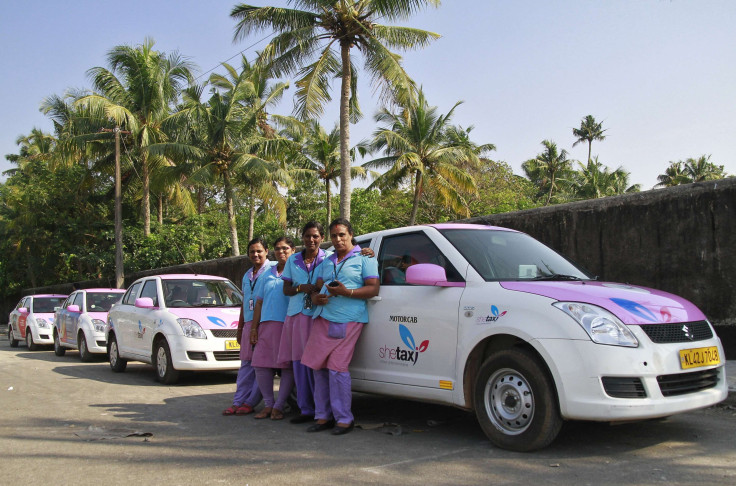After Alleged Uber Rape, Indian Car Share Services Clamor For Women Drivers But Find Few

The alleged rape of a female Uber passenger earlier this month in India shined a bright light on a problem that afflicts all car-sharing startups in India, deep-rooted sexism that makes car-sharing services no less safe for women than taxis, buses or trains. The solution, many say, is simply to recruit female drivers, but that's challenging in India where commercial driving remains a near-total male domain.
"If I took a wild guess, there might be 25 such women in Delhi,” said Nayantara Janardhan, a director at Sakha Consulting Wings, a New Delhi-based for-profit organization that runs a women-only cab-for-hire and chauffeur service.
Uber and its Indian rivals, Ola Cabs and Taxi For Sure, together have several thousands of taxis on their networks in the city, all are driven by men. In Mumbai, where a traditional black-and-yellow taxi service dominates, 7,500 new cabs will be added by April 2015 to the current fleet of 35,000, Times of India newspaper reported in November, but only 95 of those will be driven by women.
The reality in India is that most drivers come from small-town and rural India where women working outside the home is frowned upon. The deep-rooted patriarchy in the labor pool poses a challenge for all urban taxi networks and a challenge to the nascent ride-share industry.
“It has been very convenient to blame Uber,” said Nayantara. “Obviously the company has to take responsibility that such a person was driving their cab, because they market themselves as a safe option for women, but I think the buck can’t stop with them. It has to go further,” she said.
“The systemic rot is far deeper. Generations of deep-rooted patriarchy exists in our country,” she said.
Not Uber's problem
While recruiting more women drivers seems the obvious option, finding large numbers of commercially qualified ones in India isn’t going to work any time soon. Even for an organization such as Sakha, dedicated to ploughing back its profits into its women-empowering projects, it took four years to train its first 150 women, and even so, mostly to work as chauffeurs for women passengers, driving privately owned vehicles.
Only 19 today have commercial driving licenses and the badge, given out by the state’s transport department, certifying that these women drivers have qualified to ferry passengers. The process takes as long as 18 months, Nayantara said.
Most women who want to become drivers, including those who approached Sakha, come from very poor families, have little or no school education, and typically were never seen as a priority by their own parents and family as male siblings or cousins got preference.
Even after enrolling for training at Azad Foundation, Sakha’s sister organization that trains the women to become commercial drivers, many drop out because the demands of the men in their families, brothers, husbands or even sons, seen as legitimate breadwinners, are always placed first.
Often such women don’t have basic documentation either. A school certificate, if they have one, might have one name and a marriage license another. “Some women come to us with nothing,” Nayantara said.
Soaring demand
Demand for the new cab-share services, however, is soaring: People owning cars constitute between 2 percent and 3 percent of Indians, industry estimates show, while public transport options are either overburdened or unreliable or simply not accessible everywhere. For the ride-share companies, aggressive expansion is an imperative, as they compete with each other.
“The available high-quality supply is so limited that we had to create new supply,” said Anand Subramanian, director of marketing communications at ANI Technologies Pvt. Ltd., the parent company of Ola Cabs, in a telephone interview. The company is adding 10,000 cabs a month to its network, he said.
For Ola and its rivals, that aim to expand aggressively with help from investors like Accel Partners and Softbank Corp., ensuring that drivers are sensitized to the need for professional behavior at all times with all passengers is a challenge.
After the Uber rape incident, a U.S.-resident Indian woman tweeted about having complained to Uber about the same driver only a few days earlier. He had kept staring at her in his rear-view mirror, making her feel really uncomfortable, Times of India cited her as saying.
More tamper-proof technology and tougher rules can perhaps deter such drivers from actual sexual violence, but would do little to alter their perception of women.
Subramanian believes that Ola’s driver entrepreneurship initiative will go a long way towards culling out undesirable drivers and adding more responsible ones.
A year into its operations, Ola introduced a driver entrepreneurship program, in which it would link car manufacturers, banks and other lenders and also help drivers buy cars at discounted prices, Subramanian said. To date Ola has helped some 10,000 drivers buy their own cars with a combination of these loans, access to garages, dealers and second-hand car reseller networks, he said.
The combination of “driver upskilling, driver training and the driver as a car-owning entrepreneur brings a very different approach” to the operation versus someone who is an employee. The process also adds additional layers of checks and verifications, reducing the chances of habitual offenders joining the network.
What happened in a cab contracted to Uber could have equally happened in a cab from a different service, Nayantara at Sakha said. Nor can it be seen in isolation from all the other violence against women motivated by the idea that they are to remain subjugated to men in India.
Threat to patriarchy
“I think that many people would regard being a woman in India as difficult,” Lise Grande, United Nations resident coordinator, said in an interview with U.N. Radio last June. India currently ranks 136 out of 186 countries on the U.N.’s Gender Equality Index.
“Women are very poorly represented in the formal workforce, they are the victim of deep-seated prejudices, and violence against women is pervasive across all classes and all regions,” said Grande, who is also the U.N. Development Programme’s resident representative in India.
One answer is to actively encourage the presence of more women in public spaces to make it safer, Nayantara said. If there is an increasing number of women in areas considered male domains, such as driving a cab or even a bus, then it makes those spaces safer for other women as well, she said.
Sakha Consulting was started by Meenu Vadera, a former Action Aid country director in Uganda, now based in New Delhi. A nonprofit organization Azad Foundation that Vadera also founded, works to equip women with skills especially aimed at “challenging the gender stereotype,” Nayantara said.
The organization owns all its 14 cabs and the fully certified women drivers earn monthly salaries as full-time staff. They can only be hired by women, requiring male passengers to be accompanied by women or getting explicit permission from the company’s management to use these cabs alone.
“A lot of young women are entering spaces that were completely dominated by men,” Shivali Tukdeo, an assistant professor at India’s National Institute of Advanced Studies, said in an interview.
“Historically, women weren’t part of the public sphere, but a wide range of changes have brought them out of the domestic spaces. They are comfortable in these non-domestic realms and perhaps that is a bit threatening to India's entrenched patriarchy," said Tukdeo, whose recent work includes education among disadvantaged communities, ethnography of education and gender studies.
“It’s not just about individual men ... it’s our history, culture, attitudes, how our institutions operate, so these things matter,” she said.
© Copyright IBTimes 2024. All rights reserved.












